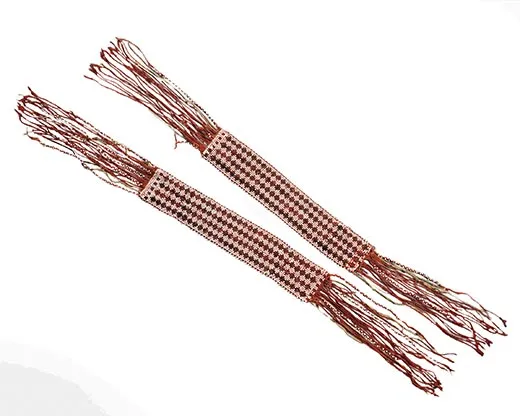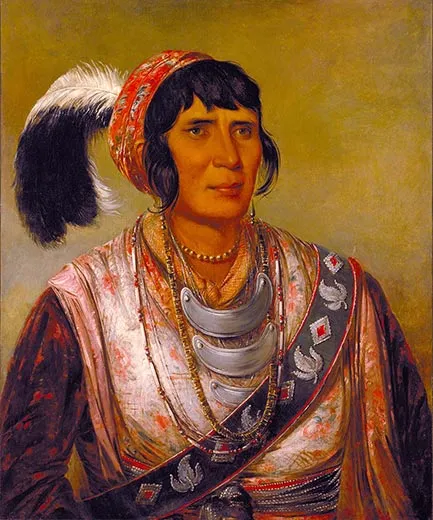A Seminole Warrior Cloaked in Defiance
A pair of woven, beaded garters reflects the spirit of Seminole warrior Osceola
/https://tf-cmsv2-smithsonianmag-media.s3.amazonaws.com/filer/Object-at-Hand-Osceola-631.jpg)
“Infinity of nations,” a new permanent exhibition encompassing nearly 700 works of indigenous art from North, Central and South America, opens October 23 at the George Gustav Heye Center in New York City, part of the Smithsonian’s National Museum of the American Indian (NMAI). The objects include a pair of woven, beaded garters worn by Billy Powell of the Florida Seminole tribe.
Billy Powell is hardly a household name. But his Seminole designation—Osceola—resonates in the annals of Native American history and the nation’s folklore. Celebrated by writers, studied by scholars, he was a charismatic war leader who staunchly resisted the uprooting of the Seminoles by the U.S. government; the garters testify to his sartorial style.
Born in Tallassee, Alabama, in 1804, Powell (hereafter Osceola) was of mixed blood. His father is thought to have been an English trader named William Powell, though historian Patricia R. Wickman, author of Osceola’s Legacy, believes he may have been a Creek Indian who died soon after Osceola was born. His mother was part Muscogee and part Caucasian. At some point, likely around 1814, when he and his mother moved to Florida to live among Creeks and Seminoles, Osceola began to insist he was a pure-blood Indian.
“He identified himself as an Indian,” says Cécile Ganteaume, an NMAI curator and organizer of the “Infinity of Nations” exhibition.
A 19th-century lithograph depicting Osceola—based on a portrait painted from life by artist George Catlin in 1838—records the warrior’s elaborate wardrobe, including a feathered hat, embroidered sash and—hanging around his neck—three crescent-shaped ceremonial metal gorgets, reminiscent of European knightly armor. The Seminole regarded Osceola, Catlin recalled, “as the master spirit and leader of the tribe.” His influence, the artist added, extended “to the remotest parts of the United States, and amongst the Indian tribes, to the Rocky Mountains.”
“He was a bit flamboyant,” says historian Donald L. Fixico of Arizona State University, who is working on a book about Osceola. “Someone in his situation—a man of mixed blood living among pure-blood Seminoles—would have to try hard to prove himself as a leader and a warrior. He wanted to draw attention to himself by dressing in a finer way.”
“The Creeks started wearing European-style clothing in the 18th century,” notes Ganteaume, “and modified it in their own ways.” The garters in the exhibition were decorative, not functional; in the lithograph, they are visible tied just beneath Osceola’s knees, worn over button-fastened leggings.
Fixico, himself a Seminole, notes that “when you sit for a portrait, you wear your Sunday best.” Though Osceola had been imprisoned by the U.S. Army and suffered from malaria when he posed for Catlin, he retains the proud bearing of a leader aware of posterity. “When his illness was at its peak,” Susan Orlean wrote in The Orchid Thief, “Osceola roused himself from his sickbed and dressed himself in his favorite outfit of large silver earrings, a feathered turban, red war paint, ostrich plumes, silver spurs, a decorated powder horn, a fancy bullet pouch, a striped blanket, and a whalebone cane. As soon as he finished dressing, he died.”
Osceola had risen to prominence as a Seminole leader when he refused to accept the Indian Removal Act—legislation proposed by President Andrew Jackson in 1830. Passed after strenuous debate in Congress (Representative David Crockett of Tennessee opposed it), the act mandated exchange of tribal lands in the South for territory west of the Mississippi River. Some Cherokee, Choctaw and Seminole chiefs went along, but Osceola and other Seminoles refused to sign the Treaty of Fort Gibson, which would have ceded their Florida homeland. In December 1835, during what became known as the Second Seminole War (1835-42), Osceola and a band of followers ambushed and killed a government agent, Wiley Thompson, and several others.
After the slayings, Osceola became a wanted man. Army troops arrested him in October 1837, while under a flag of truce. He was imprisoned, first at Fort Marion in St. Augustine, Florida, and later at Fort Moultrie, near Charleston, South Carolina.
Osceola’s capture drew national attention. “He was recognized as a defender of his people,” Ganteaume says, “and coverage in the American press made him well known.” His fame only grew after his death at Fort Moultrie three months after his arrest. Today, his renown lives on in various place names, including Osceola counties in several states and the Osceola National Forest in Florida. The legendary warrior is also the symbol of Florida State University in Tallahassee. “Osceola served as a cultural bridge between the non-Indian world and the Seminoles,” says Fixico.
Owen Edwards is a freelance writer and author of the book Elegant Solutions.
/https://tf-cmsv2-smithsonianmag-media.s3.amazonaws.com/accounts/headshot/Owen-Edwards-240.jpg)


/https://tf-cmsv2-smithsonianmag-media.s3.amazonaws.com/accounts/headshot/Owen-Edwards-240.jpg)